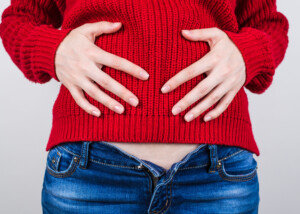
Weight gain doesn’t always mean more belly fat, and new belly fat doesn’t always mean weight gain, even in menopause.
A woman’s scale weight may stay the same, while her body composition changes over time, especially after menopause.
More visible belly fat may be the result of that undesirable change in body composition.
In 2017 The International Menopause Society released results of a study.
The researchers say that non-hormonal factors cause weight gain during menopause. A drop in estrogen shouldn’t get all the blame.
The study, led by Professor Susan Davis from the Monash University in Melbourne, Australia, explains that menopause changes the way that fat is deposited in the body.
The change in fat deposition leads to disproportionately more fat in the belly.
Nevertheless, Davis points out that the “spare tire is the body’s response to the fall in estrogen at menopause.” This shifts fat storage from a woman’s hips to the waist.
MUST a gain in body fat always come with menopause?
“Menopause can account for significant weight gain in the abdominal area and elsewhere,” says Heather Bartos, MD, a board certified OBGYN, and chief of Obstetrics & Gynecology at Texas Health Presbyterian Hospital in Denton, TX.
“After menopause women tend to gain weight not only because of the drop in estrogen but because of depression, emotional lability (eating your feelings, and there are a lot of feelings surrounding menopause), loss of muscle tone due to age and other factors,” continues Dr. Bartos.
“Changes to the diet combined with exercise and even estrogen replacement may be the best, corrective course of action for menopausal weight gain.”
Your gynecologist will discuss all available options.
Diet and Exercise Options to Combat Menopausal Weight Gain
When I was a personal trainer at a large gym, I helped many post-menopausal women lose body fat.
The typical client of post-menopausal age had a body mass index of between 25 and 30 (overweight) and 30 and over (obese).
Usually, they had already been trying to lose weight — especially in the midsection — but were not able to, even after improvements in diet.
Once I began working with these clients, I discovered that in 100 percent of them, their workout regimen was falling way short.
Formula for Efficiently Burning Fat
• Plant based diet, lots of “good” fats like olive oil, nuts, seeds and wild-caught fish.
• Limitation on processed foods.
• Most caloric meals eaten in the morning and also within a few hours of a kick-butt workout.
• Keep your hands off the treadmill.
• Employ a type of cardio called high intensity interval training twice a week.
• Emphasis on “big” moves (e.g., bench press, overhead barbell press, squat, deadlift).
Some of these clients had never strength trained and believed that only aerobics (steady state, not high intensity intervals) should burn their belly fat.
Does belly fat gain always start after menopause?
• At around age 30, a woman who has not been lifting weights begins losing muscle mass.
• Each decade thereafter she loses five pounds of muscle (unless she begins weight workouts).
• This loss of muscle causes a change in body composition.
• She may still weigh the same, but the proportion of lean muscle tissue to fat has changed.
• She now has a higher body fat percentage, even though her weight and even dress size may be the same.
• Come menopause, the excess fat will shift over into the belly more than ever before.
When Weight Training Won’t Bust Belly Fat
- Strength training isn’t intense or heavy enough.
- Strength training focuses on isolation moves like dumbbell curls, triceps kickbacks, leg curls, side bends and crunches.
I’d tell my menopausal clients, “If you do barbell squats and deadlifts, you’ll lose belly fat.”
They didn’t get this. The explanation is simple: Intense barbell squats and deadlifts will dramatically raise the body’s energy needs post-workout.
Along with a smart eating plan, the body will siphon fat out of the belly for this recovery energy.
Body fat will be lost all over the body, but for a woman with noticeable menopausal fat gain in her abdominal area, the loss of this fat will be most striking.
Workout Solutions to Belly Fat in Menopause or Weight Gain During Any Point in Life
• Trade the steady state cardio for high intensity interval training.
• Take your hands off the treadmill. Here are 10 reasons why.
• Ditch the crunch and sit-up marathons.
• Most of your strength training should consist of big compound moves like the lat pull-down, bench press, leg press and deadlift.
• Lift heavy and hard so that you’re breathing heavily and sweating.
Employ progressive resistance: always striving to get stronger and stronger rather than still be at 60 pounds on the lat pull-down after six months of training!
Finally, I always told my clients, “Becoming strong from lifting weights won’t bulk you up. Donuts will.”
 Dr. Bartos served as an assistant clinical professor of OBGYN at the Uniformed Services University of Health Sciences for several years and was a physician in the U.S. Navy for eight years.
Dr. Bartos served as an assistant clinical professor of OBGYN at the Uniformed Services University of Health Sciences for several years and was a physician in the U.S. Navy for eight years.
 Lorra Garrick is a former personal trainer certified through the American Council on Exercise. At Bally Total Fitness she trained women and men of all ages for fat loss, muscle building, fitness and improved health.
Lorra Garrick is a former personal trainer certified through the American Council on Exercise. At Bally Total Fitness she trained women and men of all ages for fat loss, muscle building, fitness and improved health.
.








































